File usage on other wikis
The following other wikis use this file:
- Usage on ar.wikipedia.org
- Usage on arz.wikipedia.org
- Usage on azb.wikipedia.org
- Usage on be.wikipedia.org
- Usage on ca.wikipedia.org
- Usage on cs.wikipedia.org
- Usage on da.wikipedia.org
- Usage on de.wikipedia.org
- Tatra Trucks
- Benutzer Diskussion:Elkawe/andere Bilder
- Usage on en.wikipedia.org
- Army of the Czech Republic
- Tatra (company)
- Czechoslovak Group
- Usage on eo.wikipedia.org
- Usage on es.wikipedia.org
- Usage on fa.wikipedia.org
- Usage on fr.wiktionary.org
- Usage on he.wikipedia.org
- Usage on id.wikipedia.org
- Usage on is.wikipedia.org
- Usage on it.wikipedia.org
- Usage on ja.wikipedia.org
- Usage on lt.wikipedia.org
- Usage on nl.wikipedia.org
- Usage on nn.wikipedia.org
- Usage on no.wikipedia.org
- Usage on pl.wikipedia.org
- Usage on pt.wikipedia.org
- Usage on ro.wikipedia.org
- Tatra (companie)
- Forțele armate ale Cehiei
- Usage on ru.wikipedia.org
- Usage on sh.wikipedia.org
- Usage on sk.wikipedia.org
- Usage on sl.wikipedia.org
- Usage on sv.wikipedia.org
- Usage on www.wikidata.org
- Usage on zh.wikipedia.org
Prewar streamliners
Tatra’s specialty was luxury cars of a technically advanced nature. In the 1930s, under Austrian engineer Hans Ledwinka and his son Erich, Tatra started building advanced, streamlined cars starting with the large Tatra T77 in 1934, the world’s first production aerodynamic car. The fastback T77’s drag coefficient of 0.212 is rarely bettered even by the sleekest modern cars. It featured, as did almost all subsequent big Tatras, a rear-mounted, air-cooled V8 engine, very technically sophisticated for the time.
Ledwinka discussed his ideas with Ferdinand Porsche who used many Tatra design features in the 1938 Kdf-Wagen, later known as the VW Beetle. This is particularly evident when compared with the smaller T97 model which had a rear-mounted, air-cooled, flat-4 engine and rounded body styling. Tatra immediately started legal action, but the matter was not resolved until 1961 when Volkswagen was ordered to pay 3,000,000 Deutsche Mark in damages.
The Tatra T603
A mere three years later, amid much dissatisfaction among officialdom about the poor-quality official cars imported from Russia, Tatra was again given permission to produce a luxury car, the famous Tatra T603. A fair successor to the prewar cars, it was also driven by a rear-engined, air-cooled V8 and had the company’s trademark aerodynamic styling. Uniquely, the Tatra T603 featured three headlights, and the first prototypes had a central rear stabilising fin, though this was lost for production. Fitted with almost American-style thick chrome bumpers with bullets (a.k.a. Dagmar bumpers), the Tatra T603 was an amazing looking car for 1955. Looks weren’t all it had going for it; performance was spritely for a large, six-seater car, and the ride was smooth as glass. Almost entirely hand-built, Tatras were not for everybody; normal citizens could not buy them. They were reserved for Party elites, Communist officials, factory presidents and other notables, as well as being exported to most other Communist nations as official cars. Even Fidel Castro had a white Tatra T603, custom-fitted with air conditioning.
Tatra T603s were built until 1975, a twenty-year reign as Communism’s finest car. Numerous improvements were made over this time, but not all the new cars built in this period were actually new. When a new Tatra replaced an old, the old vehicle was returned to the factory. There, it was upgraded to modern condition, refinished, dubbed new and sent out again as a putatively new vehicle to replace another older Tatra. This makes it hard to trace the history of surviving vehicles.
The T603 appeared in the 2005 movie Lemony Snicket’s A Series of Unfortunate Events as the other car that looks odder than the Chrysler Imperial.
Tatra 603.jpg
Tatra T603 (side view)
Voiture-603-p1010139.jpg
Tatra T603 (front)
Tatra-603-p1010140.jpg
Tatra T603 (rear)
Tatra T603 Engine.jpg
Tatra T603 (engine)
Tatra T87
«Экзотические» Татры
Нельзя обойти вниманием несколько уникальных конструкций, созданных в 30-е годы, время наивысшего расцвета таланта Ледвинки. Они демонстрируют широчайший диапазон целей, которые ставили перед собой их создатели
В 1929–1930 гг. было изготовлено 200 трехколесных грузовых Tatra-49 с платформой перед сиденьем водителя. Развозной мини-грузовичок приводился в движение одноцилиндровым бензиновым двигателем рабочим объемом 528 см3, развивавшим мощность 7 л.с. при 2 500 мин–1 . Коробка передач была 3ступенчатой, привод на заднее ведущее колесо осуществлялся карданным валом. При собственной массе 515 кг грузоподъемность машины составляла 400 кг плюс водитель и пассажир, размещавшийся за водителем на специальном сиденье с развитой боковой поддержкой. Максимальная скорость груженого экипажа достигала 50 км/ч.
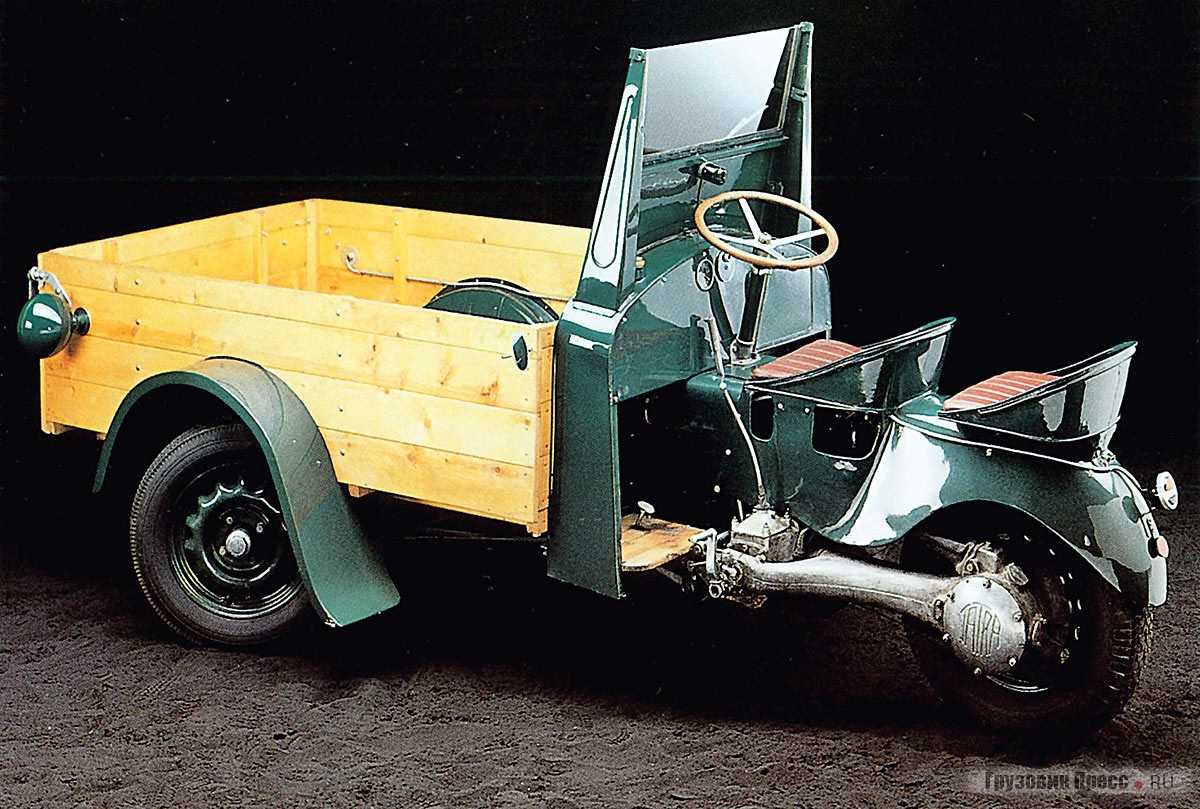
Экзотической разработкой можно назвать и опытный образец колесно-гусеничного тягача, построенный в 1930 г. Модель, известная как Tatra-25, в зависимости от условий движения могла передвигаться на колесах с приподнятыми над землей гусеницами и наоборот. Колеса не имели пневматических шин, их заменяли резиновые бандажи, поэтому скорость тягача на асфальте была небольшой. Двигатель на этой машине был бензиновый 6цилиндровый, мощностью 120 л.с. и с водяным охлаждением.

Третий из интереснейших автомобилей появился на свет в 1935 г. Специальный тягач Tatra-84 предназначался для эвакуации аварийной тяжелой техники. Его двухместная кабина располагалась над передним мостом, а за ней на раме размещался силовой агрегат , закрытый специальными кожухами. Радиаторы системы жидкостного охлаждения двигателя устанавливали вдоль машины перед грузовой платформой. Привод осуществлялся на все колеса. Бензиновый 4-цилиндровый мотор рабочим объемом 7,5 л развивал 65 л.с. при 1 500 мин–1. Топливный бак находился над двигателем за кабиной. Учитывая назначение тягача, не удивляет то, что у него были 8-ступенчатая трансмиссия (четыре передачи в основной коробке и две в делителе), лебедка в кузове с тягой 2,5 т и мощный буксирный крюк.
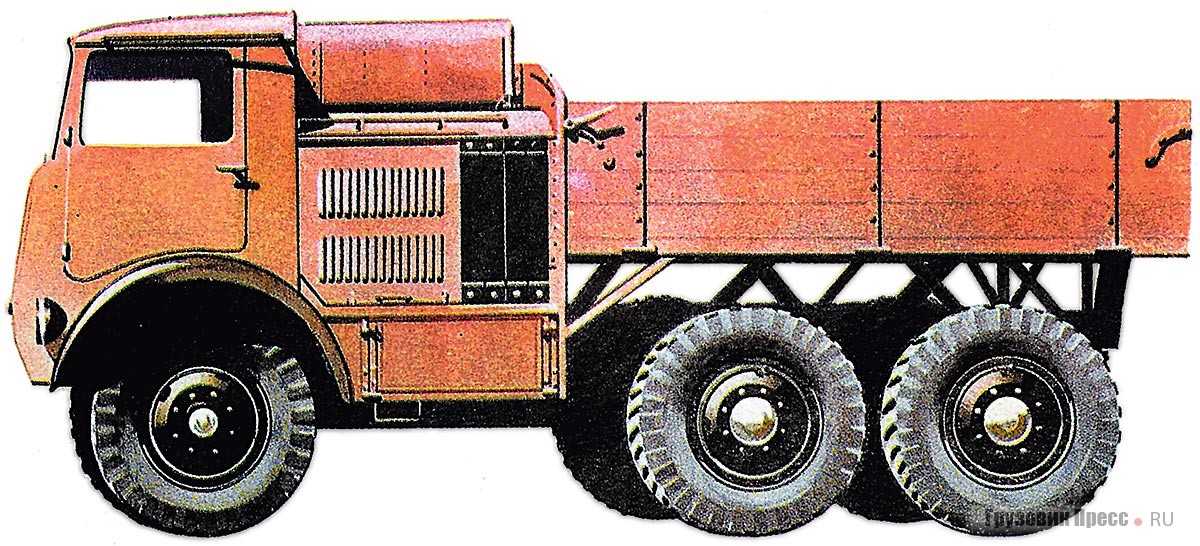
Завершая тему диапазона конструкторских разработок инженерного центра, напомним, что кроме базовых и экспериментальных моделей разрабатывалось бесчисленное количество модификаций основных версий, в том числе автобусов, троллейбусов, специальных и военных автомобилей.
А «дальше была война», и вместе с нею родилась Tatra-111, та самая, с которой началось знакомство с этой маркой советских людей. Впрочем, о ней и ее наследниках – в следующий раз.
1. Вчера 2. Сегодня 3. Завтра
Ганс Ледвинка
В 1921 г. в истории фирмы произошли знаменательные события. Практически заново был отстроен главный производственный корпус в Копрживнице. Средства на обновление дали чешские банки, сделавшие ставку на развитие местной промышленности. Кроме того, завод стал частью крупного машиностроительного концерна «Рингхоффер-Татра», а его новый директор упорно искал крупного специалиста на должность руководителя автомобильного отделения. Вспомнили о Гансе Ледвинке, молодом талантливом инженере, покинувшем предприятие в 1916 г. из-за конфликта с директором, не желавшем вкладывать средства в развитие производства автомобилей. В тот момент Ледвинка работал в Steyr, где создал ряд интересных конструкций. В 1921 г. он вернулся на Tatra, и это стало началом новой эры в истории компании.
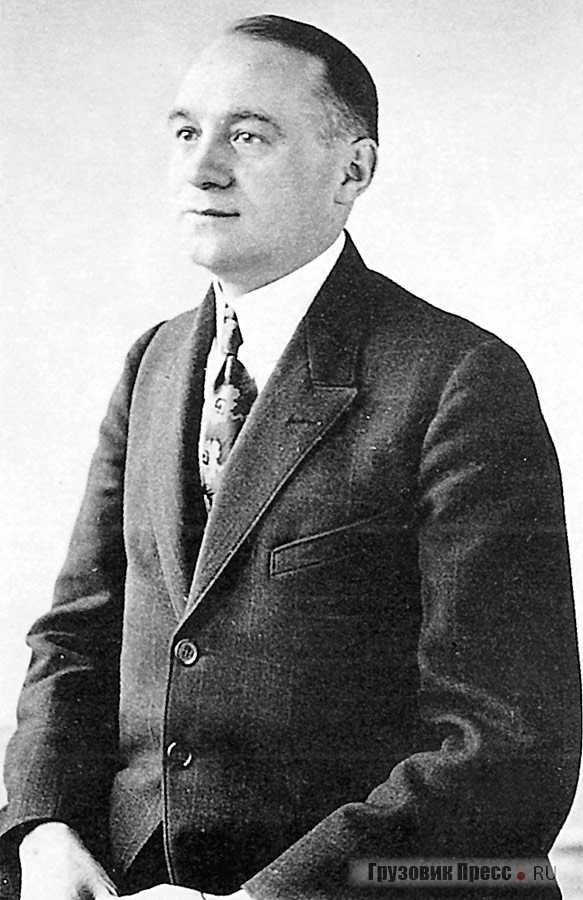
Послевоенное состояние страны наложило отпечаток на конструкцию автомобилей. Ганс Ледвинка справедливо считал, что новой массовой базовой моделью фирмы должна стать предельно простая и дешевая легковая машина, на основе которой можно создать грузовые модификации. Именно тогда и родилась знаменитая концепция Tatra с хребтовой рамой-трубой и независимой подвеской всех колес на качающихся полуосях. Двигатель крепился с одного конца трубы, главная передача – с другого. Упругие элементы в виде поперечных рессор как спереди, так и сзади опирались своими концами на полуоси, из-за чего колеса ненагруженного автомобиля приобретали некоторую «косолапость».
Предложение Ледвинки было настолько революционным, что поначалу большинство специалистов встретило его в штыки. Однако автомобили, получившие имя Tatra-11, все же построили, и в 1923 г. они совершили ряд пробегов, доказавших их высокие эксплуатационные качества. Многочисленные успехи заводских гонщиков укрепляли репутацию новых моделей. Высшим достижением стала победа, завоеванная в крупнейших автогонках по территории СССР в 1925 г. на трассе протяженностью 5 300 км.
Особо тяжелые условия выявили отличную проходимость автомобилей Tatra, их приспособленность к плохим дорогам, высокую надежность и, благодаря независимой подвеске всех колес, высокий уровень комфорта. В 1921 г. у Tatra-11 в Советском Союзе появился двойник: легкий автомобиль НАМИ-1, выпускавшийся до 1930 г. и разработанный в соответствии с концепцией Ледвинки.
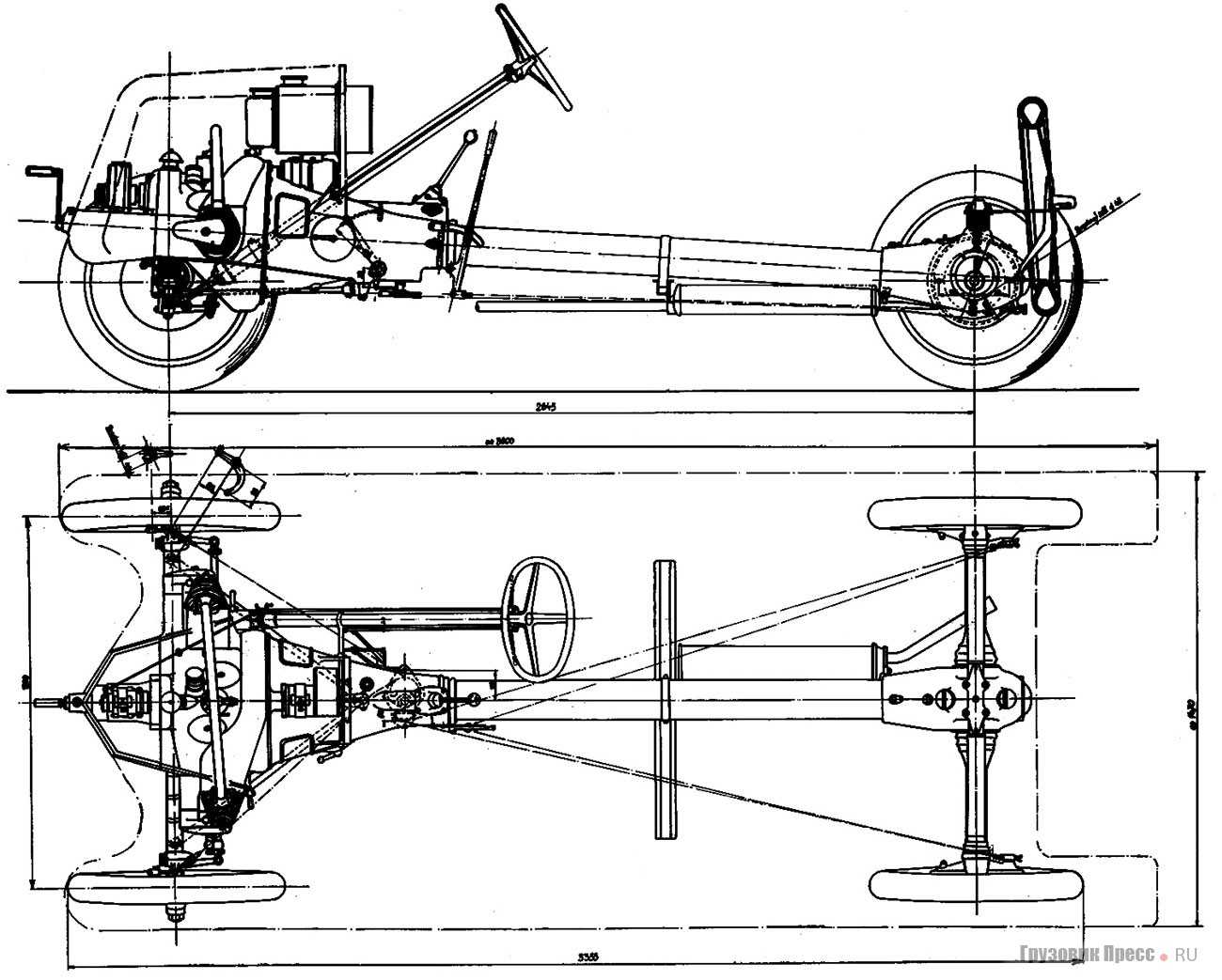

Tatra-11 весила всего 680 кг. Двухцилиндровый оппозитный двигатель с воздушным охлаждением и верхними клапанами вместе с 4-ступенчатой коробкой передач жестко соединялся с рамой-трубой диаметром 110 мм и толщиной стенки 3,0 мм. При рабочем объеме 1 056 см3 и степени сжатия 4,8 мотор развивал мощность 12 л.с. при 2 800 мин-1. Внутри трубы крутящий момент от коробки передач передавался главной передаче карданным валом. Специальная конструкция главной передачи с двумя парами тарельчатых зубчатых колес и шестерен разного диаметра позволила использовать качающиеся полуоси без установки дополнительных шарниров. При качении полуоси тарельчатое колесо перекатывалось по шестерне, одновременно передавая крутящий момент ведущему колесу.

На Tatra-11 механические тормоза устанавливались только на задних колесах, и только Tatra-12 (1926 г.) получила тормоза на все колеса. Грузовую версию назвали Tatra-13. Его грузоподъемность составляла 1,0–1,5 т в зависимости от типа кузова. В числе модификаций отметим бортовую версию, фургон, санитарный автомобиль, автобус. Tatra-13 были очень популярны. За 1925–1933 гг. их собрали 762. Для почтовой службы в 1926–1934 гг. выпустили 7 500 пикапов Tatra-12 с двигателем увеличенной до 14 л.с. мощности.

Накопленный опыт позволил распространить новую концепцию на более тяжелые модели, в том числе с колесной формулой 6х4. Шестиколесные Tatra-26/30 и Tatra-26/52 с двигателями от легковых Tatra-30 и Tatra-52 соответственно поставлялись в армию в качестве штабных, разведывательных, санитарных машин. Их вооружением были пулеметы. Легкая конструкция, независимая длинноходная подвеска всех колес и колесная формула 6х4 обеспечивали автомобилям высокую проходимость. Коробка передач с дополнительным редуктором имела восемь ступеней вперед и две назад. В качестве гражданских модификаций распространение получили версии с бортовыми платформами, санитарные, пожарные, почтовые и другие машины, включая туристические, междугородные и экскурсионные автобусы.

Tatra concept
At the end of World War I in 1918 a new country, Czechoslovakia was created incorporating Moravia and Nesseldorf became Kopřivnice. Nesselsdorfer Wagenbau was renamed Kopřivnice vozovka and in 1919 the name Tatra was given to the car range. Leopold Pasching took over control and Hans Ledwinka once more returned in 1921 to develop the revolutionary Tatra 11.
The new car, launched in 1923 featured a rigid backbone tube with swinging semi-axles at the rear giving independent suspension. The engine, front mounted, was an air cooled two cylinder unit of 1056 cc. It was replaced in 1926 by the similar T 12 which had four wheel brakes. A further development was the 1926 T 17 with 1930 cc water cooled six cylinder engine and fully independent suspension.
In 1927 the company was formally renamed as Tatra a.s..
Сроки
| Хронология моделей Татры и Нессельсдорфа (1897–1952 гг.) | ||||||||||||||||||||||||||||||||||||||||||||||||||
|---|---|---|---|---|---|---|---|---|---|---|---|---|---|---|---|---|---|---|---|---|---|---|---|---|---|---|---|---|---|---|---|---|---|---|---|---|---|---|---|---|---|---|---|---|---|---|---|---|---|---|
| Тип | Nesselsdorfer Wagenbau-Fabriks-Gesellschaft | Татра как | ||||||||||||||||||||||||||||||||||||||||||||||||
| 1890-е годы | 1900-е годы | 1910-е годы | 1920-е годы | 1930-е годы | 1940-е годы | 1950-е годы | ||||||||||||||||||||||||||||||||||||||||||||
| 6-е | 7-е | 8-е | 9 | 1 | 2 | 3 | 4-й | 5 | 6-е | 7-е | 8-е | 9 | 1 | 2 | 3 | 4-й | 5 | 6-е | 7-е | 8-е | 9 | 1 | 2 | 3 | 4-й | 5 | 6-е | 7-е | 8-е | 9 | 1 | 2 | 3 | 4-й | 5 | 6-е | 7-е | 8-е | 9 | 1 | 2 | 3 | 4-й | 5 | 6-е | 7-е | 8-е | 9 | 1 | 2 |
| Маленькая машина | 12-е | |||||||||||||||||||||||||||||||||||||||||||||||||
| 57 / 57A / 57B | ||||||||||||||||||||||||||||||||||||||||||||||||||
| Средний класс | Т | 20-е | 30-е | |||||||||||||||||||||||||||||||||||||||||||||||
| Д. | S4 | 30/52 | ||||||||||||||||||||||||||||||||||||||||||||||||
| С. | Л. | |||||||||||||||||||||||||||||||||||||||||||||||||
| Высший класс | президент | А. | Б. | Э. | Ф. | J30 | S6 | U | 17-е | 31 год | 70 / 70A | |||||||||||||||||||||||||||||||||||||||
| J40 | 77 / 77A | |||||||||||||||||||||||||||||||||||||||||||||||||
| Внедорожник | 57 К | |||||||||||||||||||||||||||||||||||||||||||||||||
| V 750 | V 799 | V 809 | ||||||||||||||||||||||||||||||||||||||||||||||||
| 82/92/93 | ||||||||||||||||||||||||||||||||||||||||||||||||||
| Фургоны | ||||||||||||||||||||||||||||||||||||||||||||||||||
| 26/30/26/52 | ||||||||||||||||||||||||||||||||||||||||||||||||||
| 13-е | ||||||||||||||||||||||||||||||||||||||||||||||||||
| 43 год | ||||||||||||||||||||||||||||||||||||||||||||||||||
| грузовая машина | K | 25-е | ||||||||||||||||||||||||||||||||||||||||||||||||
| М. | TL2 | |||||||||||||||||||||||||||||||||||||||||||||||||
| Р. | TL4 | 22-е | ||||||||||||||||||||||||||||||||||||||||||||||||
| 81 год | … | |||||||||||||||||||||||||||||||||||||||||||||||||
| омнибус | О | ТАК | К | … | ||||||||||||||||||||||||||||||||||||||||||||||
|
Модель Nesselsdorf |
| Хронология моделей Tatra (с 1953 г.) | ||||||||||||||||||||||||||||||||||||||||||||||||||||
|---|---|---|---|---|---|---|---|---|---|---|---|---|---|---|---|---|---|---|---|---|---|---|---|---|---|---|---|---|---|---|---|---|---|---|---|---|---|---|---|---|---|---|---|---|---|---|---|---|---|---|---|---|
| Тип | 1950-е годы | 1960-е | 1970-е годы | 1980-е годы | 1990-е | 2000-е | 2010-е | |||||||||||||||||||||||||||||||||||||||||||||
| 3 | 4-й | 5 | 6-е | 7-е | 8-е | 9 | 1 | 2 | 3 | 4-й | 5 | 6-е | 7-е | 8-е | 9 | 1 | 2 | 3 | 4-й | 5 | 6-е | 7-е | 8-е | 9 | 1 | 2 | 3 | 4-й | 5 | 6-е | 7-е | 8-е | 9 | 1 | 2 | 3 | 4-й | 5 | 6-е | 7-е | 8-е | 9 | 1 | 2 | 3 | 4-й | 5 | 6-е | 7-е | 8-е | 9 | 1 |
| Высший класс | ||||||||||||||||||||||||||||||||||||||||||||||||||||
| Фургоны | бета | |||||||||||||||||||||||||||||||||||||||||||||||||||
| грузовая машина | ||||||||||||||||||||||||||||||||||||||||||||||||||||
| 163 / Джамал | ||||||||||||||||||||||||||||||||||||||||||||||||||||
| … | 815 / 815-6 (816) / ARMAX / TERRN ° 1 / 815-7 (817) | |||||||||||||||||||||||||||||||||||||||||||||||||||
| омнибус | … | |||||||||||||||||||||||||||||||||||||||||||||||||||
Captions
Captions
EnglishAdd a one-line explanation of what this file represents
Summary
edit
Licensing
edit
| This logo image consists only of simple geometric shapes or text. It does not meet the threshold of originality needed for copyright protection, and is therefore in the public domain. Although it is free of copyright restrictions, this image may still be subject to other restrictions. See or Template talk:PD-textlogo for more information. |
| This work includes material that may be protected as a trademark in some jurisdictions. If you want to use it, you have to ensure that you have the legal right to do so and that you do not infringe any trademark rights. See our general disclaimer.This tag does not indicate the copyright status of the attached work. A normal copyright tag is still required. See Commons:Licensing. |
Original upload log
edit
Transferred from to Commons by Wdwdbot using script bot_filetrans.pl (r26M).
The original description page was here. All following user names refer to de.wikipedia.
- 2008-11-17 19:18:54 Marsupilami (4040 Bytes) Farbfix, +Rand, +DOCTYPE
- 2008-06-28 08:51:14 Marsupilami (3835 Bytes) {{Information |Beschreibung = Logo |Quelle = http://www.tatra.cz/cz/politika_cz.pdf |Urheber = Quelle konvertiert von ] |Datum = 28.06.2008 |Genehmigung = |Andere Versionen = |Genehmigung=Aufgrund geringer [[Schöpfungsh
File history
Click on a date/time to view the file as it appeared at that time.
| Date/Time | Thumbnail | Dimensions | User | Comment | |
|---|---|---|---|---|---|
| current | 16:00, 25 May 2015 | 768 × 768 (4 KB) | Wdwdbot | Bot Move: Original uploader of this revision (#2) was Marsupilami at de.wikipedia | |
| 15:59, 25 May 2015 | 768 × 768 (4 KB) | Wdwdbot | Bot Move: Original uploader of this revision (#1) was Marsupilami at de.wikipedia |
File usage on other wikis
The following other wikis use this file:
- Usage on ar.wikipedia.org
- Usage on arz.wikipedia.org
- Usage on azb.wikipedia.org
- Usage on be.wikipedia.org
- Usage on ca.wikipedia.org
- Usage on cs.wikipedia.org
- Usage on da.wikipedia.org
- Usage on de.wikipedia.org
- Tatra Trucks
- Benutzer Diskussion:Elkawe/andere Bilder
- Usage on en.wikipedia.org
- Army of the Czech Republic
- Tatra (company)
- Czechoslovak Group
- Usage on eo.wikipedia.org
- Usage on es.wikipedia.org
- Usage on fa.wikipedia.org
- Usage on fr.wiktionary.org
- Usage on he.wikipedia.org
- Usage on id.wikipedia.org
- Usage on is.wikipedia.org
- Usage on it.wikipedia.org
- Usage on ja.wikipedia.org
- Usage on lt.wikipedia.org
- Usage on nl.wikipedia.org
- Usage on nn.wikipedia.org
- Usage on no.wikipedia.org
- Usage on pl.wikipedia.org
- Usage on pt.wikipedia.org
- Usage on ro.wikipedia.org
- Tatra (companie)
- Forțele armate ale Cehiei
- Usage on ru.wikipedia.org
- Usage on sh.wikipedia.org
- Usage on sk.wikipedia.org
- Usage on sl.wikipedia.org
- Usage on sv.wikipedia.org
- Usage on www.wikidata.org
- Usage on zh.wikipedia.org
Metadata
This file contains additional information such as Exif metadata which may have been added by the digital camera, scanner, or software program used to create or digitize it. If the file has been modified from its original state, some details such as the timestamp may not fully reflect those of the original file. The timestamp is only as accurate as the clock in the camera, and it may be completely wrong.
| Width | 768 |
|---|---|
| Height | 768 |
Licensing edit
| This logo image consists only of simple geometric shapes or text. It does not meet the threshold of originality needed for copyright protection, and is therefore in the public domain. Although it is free of copyright restrictions, this image may still be subject to other restrictions. See or Template talk:PD-textlogo for more information. |
| This work includes material that may be protected as a trademark in some jurisdictions. If you want to use it, you have to ensure that you have the legal right to do so and that you do not infringe any trademark rights. See our general disclaimer.This tag does not indicate the copyright status of the attached work. A normal copyright tag is still required. See Commons:Licensing. |
1970s makeover—the Tatra T613
File:Tatra 613-4.jpg
Tatra T613-4 Mi Long Model 1995
File:Tatra T613 Engine.jpg
Tatra T613 V8 petrol air cooled engine
In 1968 a replacement was developed; the Tatra T613. It was styled by the Italian styling house of Vignale and was a more modern, less rounded shape. It was not until 1973 that any were actually produced by the factory, and volume production did not begin until the following year. Although the layout remained the same, the body and engine were all new, the unit being equipped with 4 overhead camshafts, a greater volume (3495 cc) and delivering close to 165 bhp. In addition, it had been moved somewhat forward for improved balance. These cars were built in 5 series and several modifications until 1996. It is a tribute to Vignale’s excellent styling that they did not look outdated until rather late in that time period. Over 11,000 cars were built, slowing to a trickle of but a few dozen a year towards the end as Tatras began to seem more and more outdated.
Early years
Ignác Šustala (1822 — 1891), founder of the company in what was then Nesseldorf, Moravia, started the production of horse-drawn vehicles in 1850. In 1891 he branched out into railway wagon manufacture naming the company Nesselsdorfer Wagenbau-Fabriksgesellschaft and employed Hugo Fischer von Roslerstam as technical director in 1890. After the death of Šustala, von Roslerstam took over running the company and in 1897 he bought a Benz automobile. Using the Benz for inspiration the company made its first car, the Präsident which was exhibited in 1897 in Vienna. Orders were obtained for more cars and under the direction of a new young engineer called Hans Ledwinka (1878-1967) ten improved cars were made.
The first car to be totally designed by Ledwinka came in 1900 with the Type A with rear mounted 2714 cc engine and top speed of 40 km/h of which 22 were made. This was followed by the Type B with central engine in 1902 but then Ledwinka left the company to concentrate on steam engine development. He returned in 1905 and designed a completely new car, the Type S with 3308 cc 4 cylinder engine. Production was badly hit in 1912 with a 23 week strike and Hugo Fischer von Roslerstam left the company.
Расширение модельного ряда
В 1926 г. началось производство грузового автомобиля Tatra-23 с 4-цилиндровым бензиновым двигателем водяного охлаждения. На его базе была разработана трехосная Tatra-24 грузоподъемностью 6,0 т. Впервые на этих машинах кабина располагалась над передним мостом, что выдвигало их на передовые позиции даже по мировым масштабам
Важно отметить, что на модели «24» прошла апробацию первая в истории фирмы пневматическая подвеска задних колес, в то время так и не оцененная
В 1927 г. название компании изменилось с «Копрживницка возовка – акционерное общество» на «Заводы Татра, а.о.». К этому времени было выпущено свыше 8 тыс. автомобилей всех типов, на заводе работало 3 тыс. рабочих и 300 служащих. Ежегодно с конвейера сходило до 4 тыс. легковых и грузовых автомобилей при сохранении выпуска до 800 вагонов в год.

В 1930 г. появился первый грузовик Tatra с гидроприводом тормозов. Модель «27» оказалась настолько удачной, что продержалась в производстве до 1947 г. Дальнейшим развитием шестиколесных моделей 26/30 стала Tatra-72 (1933 г.). Конструкция этого автомобиля была настолько совершенной, что лицензию на ее производство приобрела французская «Лорен-Дитрих».
Знакомясь с развитием конструкций грузовых «Татр», невольно поражаешься размаху конструкторских и исследовательских работ, проводившихся под руководством Ледвинки. Отрабатывалась и доводилась до совершенства конструкция легких трехосных грузовиков 6х4. На них применялись 4-цилиндровые верхнеклапанные бензиновые двигатели водяного охлаждения и, с начала 3, дизели. В то время, когда еще не были освоены в массовом производстве шарниры равных угловых скоростей, именно такие модели имели наилучшую проходимость. На их шасси монтировалось множество типов кузовов, в большинстве военного назначения.


Tatra-72 (1933–1935 гг.) сменило на конвейере семейство Tatra-82 (1935–1937 гг.), а затем, в 1937-м, Tatra-92. В 1938 г. руководство приняло решение об упразднении легких шестиколесных автомобилей из типажа фирмы. Последним из них был грузовик Tatra-93 (1937–1938 гг.) с новым верхнеклапанным двигателем V8, развивавшим 70 л.с. при рабочем объеме 4,0 л. Двигатель имел воздушное охлаждение. Кроме заднего моста модель оснащалась также и передним ведущим мостом.
Средние армейские трехосные грузовики, разработанные в соответствии с концепцией Ледвинки, непрерывно совершенствовались. Их грузоподъемность варьировалась от 3 до 8 т, а начало «династии» положил выпуск Tatra-25 (1933–1934 гг.) и Tatra-22 (1934–1945 гг.), оснащенных парой «висячих» двускатных колес малого диаметра, закрепленных на раме перед передним мостом для облегчения преодоления рвов. На смену Татра-22 пришло семейство Татра-29 (1934–1935 гг.), унифицированное по агрегатам с двухосными Tatra-27.


Тяжелая серия трехосных машин появилась на конвейере в 1936 г. Первенцами были капотные Tatra-85 (1936–1938 гг.), вскоре дополненные модификациями Tatra-85/91 с кабиной над двигателем. Параллельное производство двух версий продолжалось до 1939 г., когда им на смену пришел грузовик Tatra-81 (1939–1942 гг.), непосредственный предшественник знаменитой Tatra-111. Татра-81 выпускалась с 6-цилиндровым дизелем воздушного охлаждения, а ее грузоподъемность составляла 6,5 т.
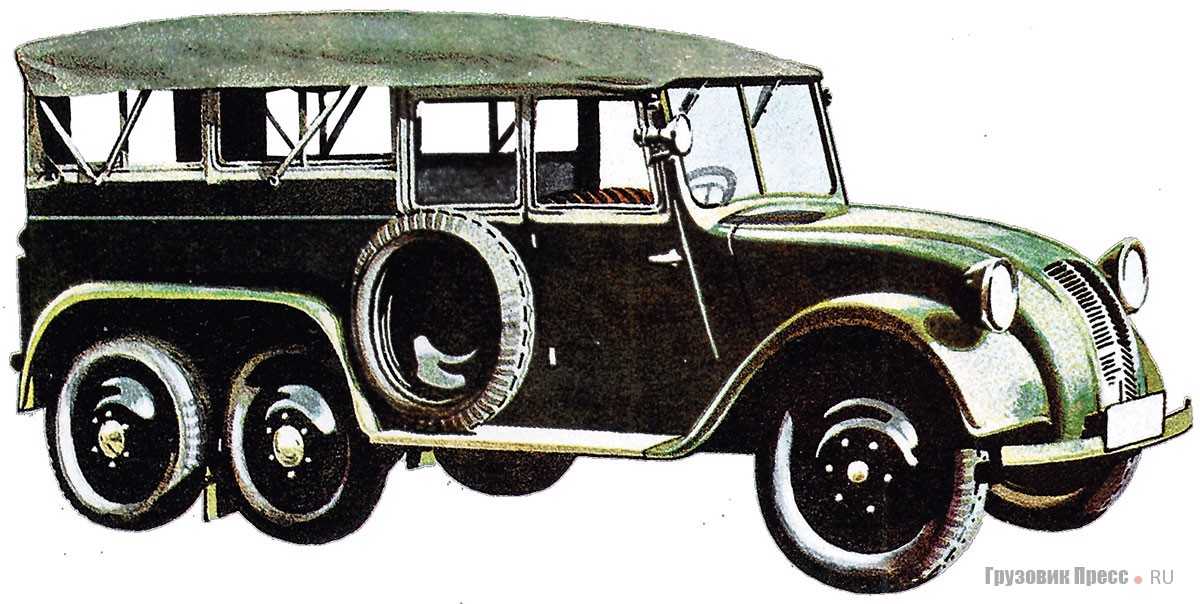

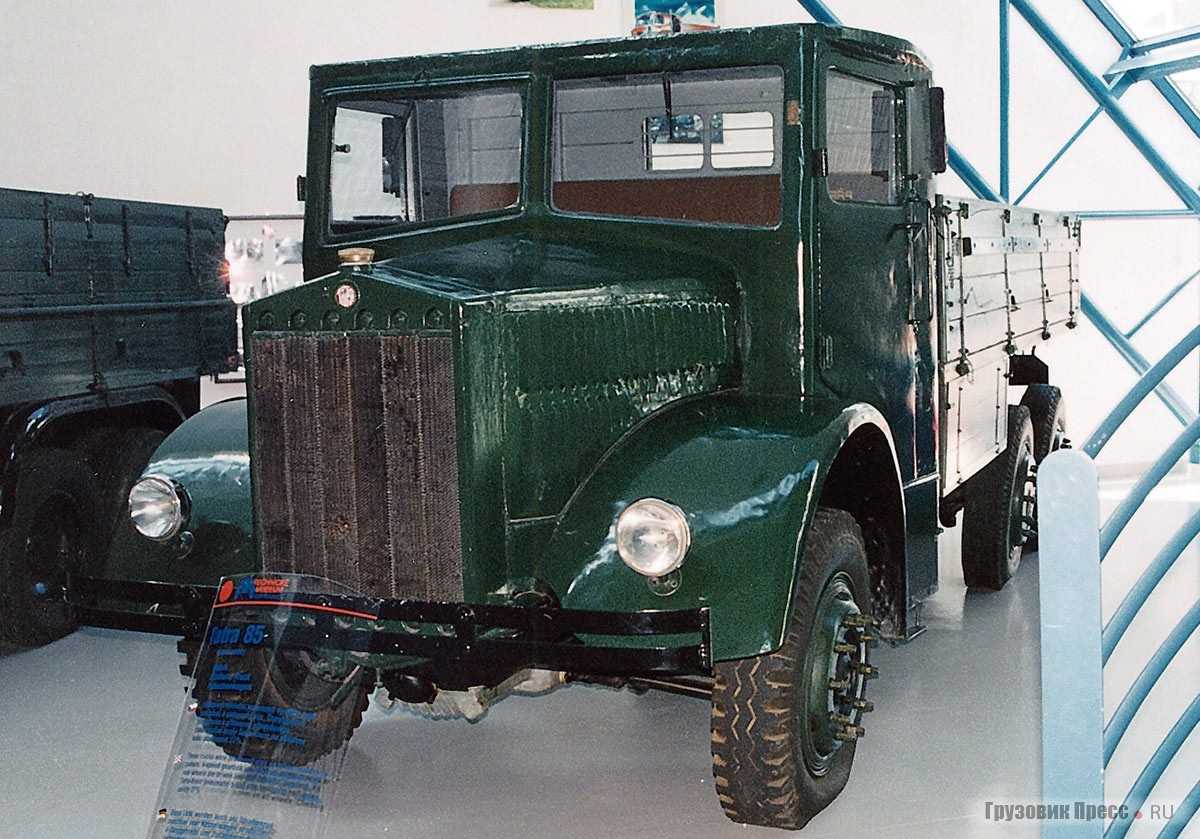
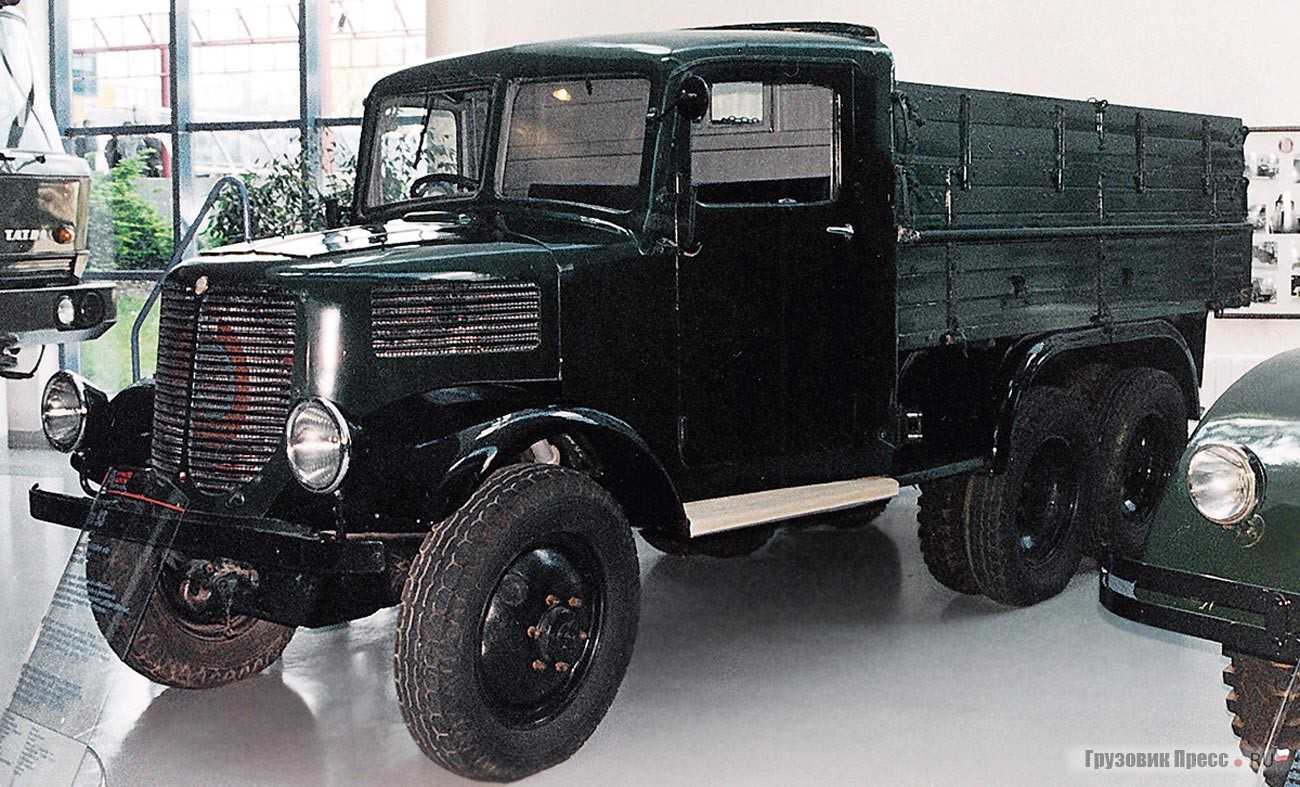
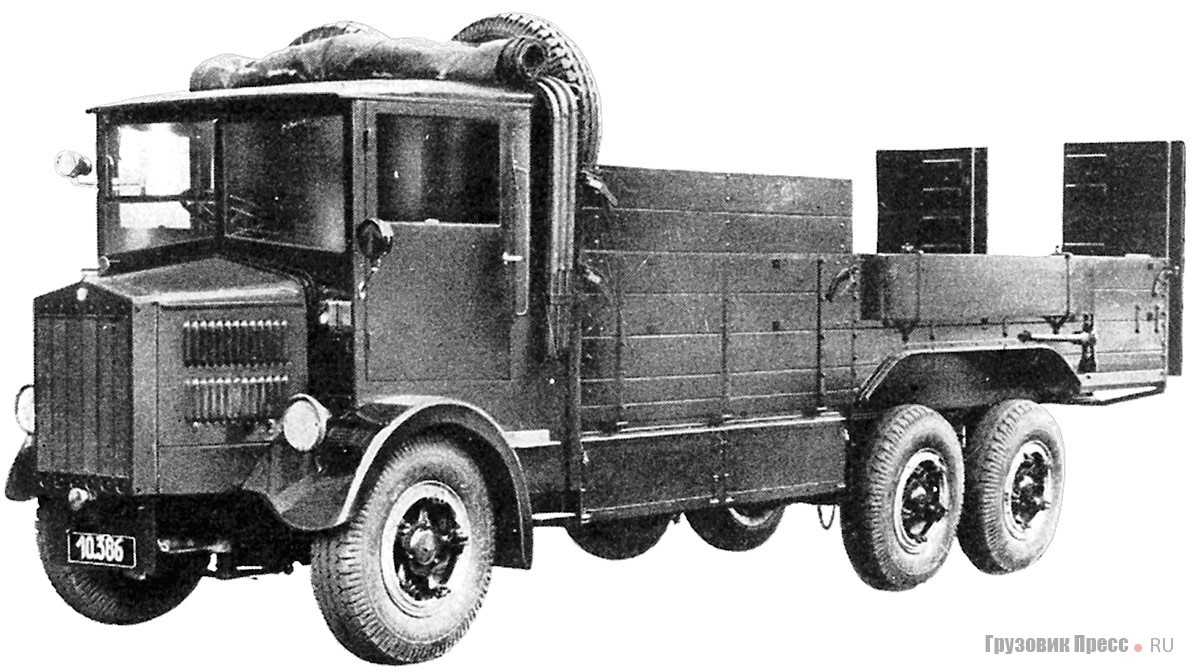
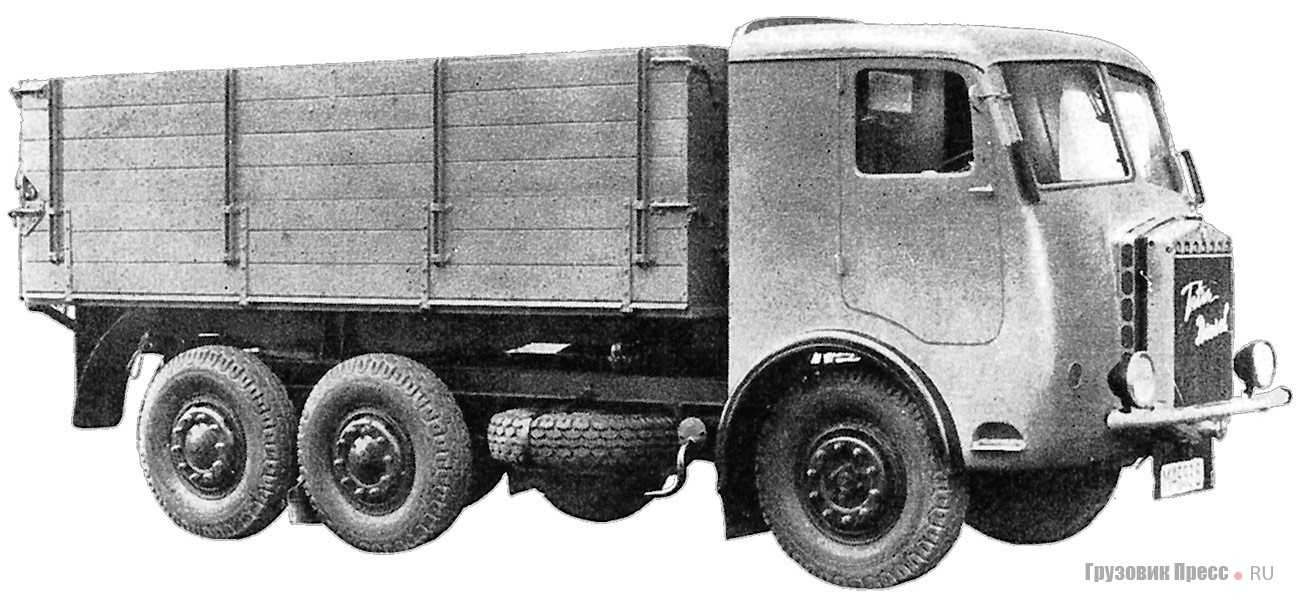
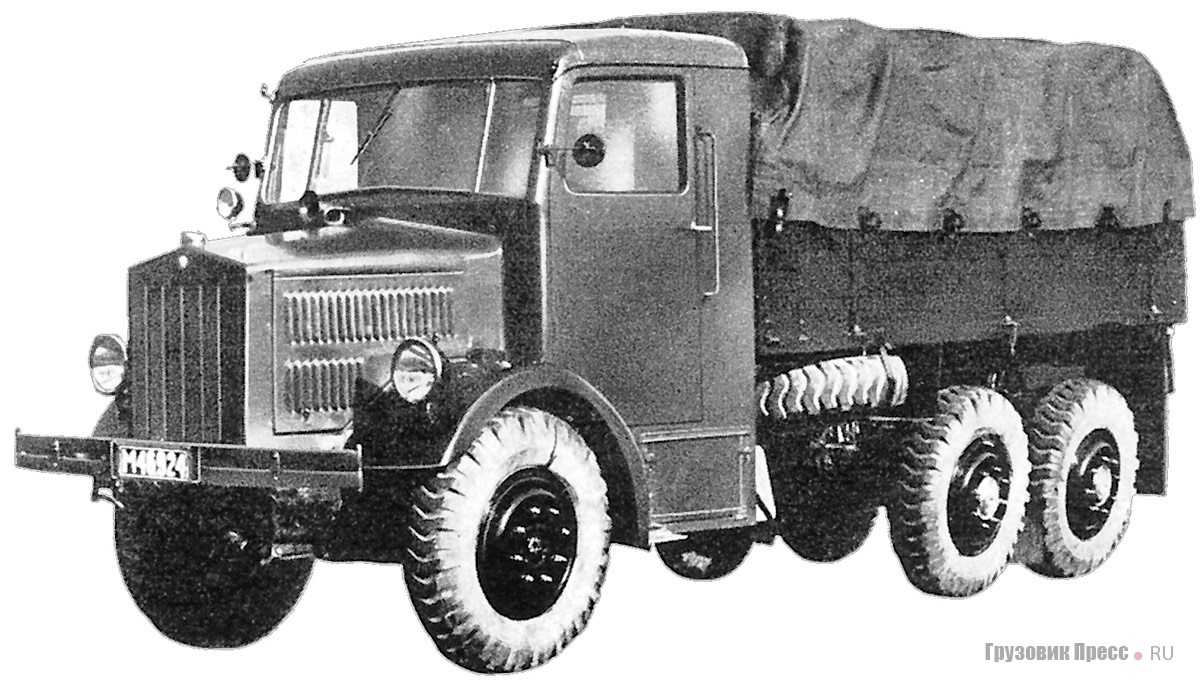
Final steps, and the end
With orders and production almost at a standstill after the fall of Communism, Tatra decided to stop building the Tatra T613 in 1996. An attempt was made to produce an updated version, the Tatra T700; it was largely based on the old car, with updated body panels and detail. Sales were poor, and in 1999 Tatra abandoned the manufacture of cars.
No such fate has met Tatra’s truck production, which is quite successful.
The United States Terex Corporation acquired the majority ownership (71%) of Tatra in late 2003. However, as of 2006, the majority ownership lies in the hands of Blue River’s owner, Ronald Adams of Fort Worth, Texas.
Исторические дорожные транспортные средства
Легковые автомобили
| Тип | Период строительства |
|---|---|
| Татры 10 | 1923-1925 гг. |
| Татра 11 | 1923-1926 гг. |
| Татры 12 | 1926-1934 гг. |
| Татры 17 | 1925-1927 гг. |
| Татры 20 | 1923-1925 гг. |
| Татры 26/30 | 1927-1933 |
| Татра 26/52 | 1931 г. |
| Татры 30 | 1926-1930 гг. |
| Татра 30/52 | 1929-1930 гг. |
| Татры 31 | 1926-1930 гг. |
| Татры 52 | 1930-1938 |
| Татра 52 спорт | 1930-1938 |
| Татры 54 | 1931-1934 гг. |
| Татры 57 | 1932-1935 гг. |
| Татра 57 А | 1936-1938 гг. |
| Татра 57 B | 1938-1949 |
| Татры 70 | 1931-1932 гг. |
| Татра 70 А | 1934-1947 гг. |
| Татры 75 | 1933-1942 гг. |
| Татры 77 | 1934-1935 гг. |
| Татра 77 А | 1935-1936 гг. |
| Татра 80 | 1931-1935 гг. |
| Татры 87 | 1937-1950 гг. |
| Тестовый автомобиль Tatra 87-603 | 1950/1964 |
| Татра 90 прототип | 1935 г. |
| Татры 97 | 1937-1946 гг. |
| Татры 107 | 1946-1947 гг. |
| Татра 201 прототип | 1947 г. |
| Татра 600 Татраплан | 1947–1952 |
| Дизельный прототип Tatra 600 | 1952 г. |
| Татры 603 | 1956-1963 гг. |
| Tatra 603 A прототип | 1955 г. |
| Tatra 603 X прототип | 1967 |
| Татра 2-603 | 1963-1968 |
| Татры 3-603 | 1969 г. |
| Tatra 604 прототип | 1954 г. |
| Татры 613 | 1973–1996 |
| Татры 623 | 1980–1998 |
| Татры 700 | 1996–1999 |
| Опытный образец Tatra Prezident | 1994 г. |
| Tatra V 570 прототип | 1933 г. |
Гоночные и спортивные автомобили
Tatra 607, постройки 1950, 1989 на Нюрбургринге.
| Тип | Период строительства |
|---|---|
| Татра 12 Тарга Флорио | 1925 г. |
| Татра 30 спорт | 1926 г. |
| Tatra 601 Монте-Карло | 1949–1952 |
| Татра 602 Татраплан Спорт | 1949–1952 |
| Татра 2-603 В5 | 1966-1967 |
| Татра 2-603 В6 | 1968 г. |
| Татры 605 | 1956 г. |
| Tatra 607 monoposto | 1950 |
| Татра 607-2 монопосто | 1951–1958 |
| Татры 625 | 1986 г. |
| Татранский дельфин | 1963 г. |
| Татра JK 2500 | 1954 г. |
Внедорожник
| Тип | Период строительства |
|---|---|
| Татра V 750 | 1935-1937 гг. |
| Татра V 799 | 1938 г. |
| Татра V 809 | 1940-1942 |
| Татра 57 К | 1941-1948 гг. |
| Татры 82 | 1935-1937 гг. |
| Татры 92 | 1937-1941 гг. |
| Татры 93 | 1939 г. |
| Tatra 803 прототип | 1950 |
| Tatra 804 прототип | 1951 г. |
Микроавтобус и автовоз
Микроавтобус Tatra в Братиславе
| Тип | Период строительства |
|---|---|
| Tatra 603 MB (микроавтобус) прототип | 1961 г. |
| Татра Бета (пикап) | 1996–1999 |
Грузовики
Татры 141
Татра 148
Tatra 813 8×8 с советским ГАЗ-63 на погрузочной площадке
Татры 815
Татры ТЕРРNo1
Tatra TERRNo1 8 × 8 в разведке золота, Западная Австралия
| Тип | Период строительства |
|---|---|
| Татра TL 2 | 1915-1924 гг. |
| Татра TL 4 | 1916-1924 гг. |
| Татры 13 | 1924-1933 гг. |
| Татры 22 | 1934-1935 гг. |
| Татры 23 | 1926-1931 гг. |
| Татры 24 | 1926-1931 гг. |
| Татры 25 | 1933-1934 гг. |
| Татры 27 | 1930-1947 гг. |
| Татры 28 | 1931-1935 гг. |
| Татры 43 | 1931-1938 гг. |
| Татры 49 | 1929-1930 гг. |
| Татры 72 | 1933-1937 гг. |
| Татры 81 | 1939-1942 гг. |
| Tatra 84 прототип | 1935 г. |
| Татры 85 | 1936-1941 гг. |
| Татры 111 | 1942-1962 гг. |
| Татры 114 | 1947-1948 гг. |
| Татры 115 | 1948-1949 |
| Tatra 116,117,120 2-осные прототипы | 1948–1952 |
| Tatra 118,119,122 3-осных прототипа | 1948–1952 |
| Татры 128 | 1951–1952 |
| Tatra 130 прототип | 1951 г. |
| Tatra 131 прототип | 1951 г. |
| Tatra 137 прототип | 1956 г. |
| Татры 138 | 1959–1971 |
| Татры 141 | 1957-1970 гг. |
| Татры 147 | 1957-1961 гг. |
| Татра 148 | 1972–1982 |
| Tatra 157 прототип | 1972–1974 гг. |
| Tatra 165 прототип | 1994-2000 гг. |
| Татры 805 | 1953-1960 гг. |
| Татры 813 | 1967–1982 |
| Татры 815 | 1982-2008 гг. |
Омнибусы и троллейбусы
| Тип | Период строительства |
|---|---|
| Татры 24 | 1926-1931 гг. |
| Татры 27 | 1930-1947 гг. |
| Татры 43 | 1931-1938 гг. |
| Татры 72 | 1933-1937 гг. |
| Татры 86 | 1936-1939 гг. |
| Татры 114 | 1947-1948 гг. |
| Татра 400 | 1948-1955 |
| Tatra 401 прототип | 1958 г. |
| Татра 500 | 1954–1957 |
Военная техника
Tatra 815 как аварийный автомобиль THW
| Тип | тип | Период строительства |
|---|---|---|
| Татры 111 | грузовая машина | 1942-1962 гг. |
| Татры 805 | легкий грузовик | 1953-1960 гг. |
| Татры 809 | Полугусеничный автомобиль | |
| Татры 813 | тяжелый грузовик | 1967–1982 |
| Татра ОТ-64 | Бронеавтомобиль 8×8 в кооперации с Польшей на базе Tatra 813 | |
| Татра ОТ 810 | Полугусеничный автомобиль — копия немецкого среднего танка SPW Sd.Kfz. 251 | |
| ДАНА | Самоходная гаубица , ходовая часть и привод Татры 815 | |
| Следующий Тит | Бронемашины 6×6 , в сотрудничестве с Nexter Systems | 2013- |
Meaning and history
1897 – 1920
The original Tatra logo was a sort of metallic rhombic plaque with the company name put onto its central plane. The letters were all over the place and really looked carved into rather than made with some sort of typographic tool. It was very artistic.
1920 – 1936
In 1920, they produced the first version of what later became their iconic emblem. It was a red circle with white letters depicted haphazardly on it. This emblem was then put onto a metallic badge shaped like a vial. There was a big red space in its center, and the emblem was in its top.
1936 – 1950
The 1936 emblem is a 2D edition of the same round symbol, except with an additional white outline. There was also a sort of illustrative minimalistic wing sprouting from its top left corner and colored the same shade of red.
1950 – 1989
For a few decades, Tatra tried using a new design – this one. It’s a black wordmark of the brand’s name, although it didn’t use standard letters. Rather, it was a collection of round blots shapes and lines fused together by a few more lines to make an impression of something mechanical.
1989 – 1999
The initial Tatra badge was created in 1897 and is still kept as the basis for the company’s visual identity. It was a flat dark red circular badge in a thick double outline of white and red, and a vertically stretched sans-serif logotype in white, with both it is top and bottom contours arched to fit the circular framing of the emblem.
1999 – Today
The visual identity of the Czech automaker has been changed several times throughout its history, but he always been text-based. The latest version of the Tatra logo is a modified emblem from the 1990s, which looks bright and contemporary.
The emblem is composed of a scarlet red circle in a delicate silver outline, where the custom sans-serif lettering is enclosed. The wordmark in white features its letters capitalized and arched both on their top and bottom parts in order to repeat the circular shape of the badge.
In the printed materials and official document, the Tatra logo had its silver outline replaced by a double red and white, which makes it look stricter and more professional.
The red and white color palette of the brand’s visual identity is a perfect reflection of power and passion, along with the company’s energy in moving forward and implementing new technologies and principles in its manufacturing process. The silver outline of the badge adds style and a sense of modernity and makes the emblem look balanced and cool when placed on the car.
Monte-Carlo Automobiles Logo
Korres Engineering Logo
Sin Cars Logo































